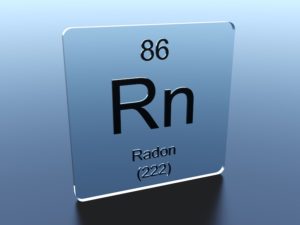Radon is a naturally occurring gas that forms when radioactive elements—such as uranium, radium and thorium—break down in soil and rock. This colorless, odorless and radioactive gas can pass through soil and rock into the air, as well as into underground and surface water.
 Because of its natural occurrence in soil, radon can be located in low levels outdoors and in drinking water that comes from rivers and lakes. It can enter homes through cracks found in the foundation, walls or floors and collect inside over time. As a result, the basement and first floors in homes usually have the highest radon levels because of their proximity to the ground. Homes with tight insulation and/or are built in soil rich in radioactive elements may have higher levels of radon.
Because of its natural occurrence in soil, radon can be located in low levels outdoors and in drinking water that comes from rivers and lakes. It can enter homes through cracks found in the foundation, walls or floors and collect inside over time. As a result, the basement and first floors in homes usually have the highest radon levels because of their proximity to the ground. Homes with tight insulation and/or are built in soil rich in radioactive elements may have higher levels of radon.
Along with seeping up from the ground, extremely low-level exposure can be due to building materials that may be made from natural radon-containing substances, including:
If you suspect your soil may contain higher than normal levels of radioactive elements, seek out a professional to have your home tested or buy a testing kit from a local hardware store.
It should be noted that radon may also be found in certain high-risk occupations, including working underground (i.e., certain types of mining), working in facilities that process uranium or working with phosphate fertilizers that may have high levels of uranium.
Radon gas breaks down into solid radioactive elements known as radon progeny. The radon progeny then attaches itself to airborne particles—such as dust—and may be inhaled. Long-term exposure to this over time can damage the DNA in the body’s cells.
Though cigarette smoking is still the leading cause of lung cancer, radon comes in at a close second; it is estimated that 5,000 to 22,000 lung cancer deaths in the United States each year are related to radon, according to the National Institutes of Health.
Radon is a statewide health issue because of a geological formation known as the Reading Prong, according to the Department of Environmental Protection. Homes built along this formation—which stretches from Pennsylvania through northwestern New Jersey and into southern New York State – have tested positive for high indoor levels of radon. Even homes beyond the Reading Prong have tested positive for elevated levels of the gas.
Currently, is it estimated that among the annual 4,700 lung cancer deaths in New Jersey, 140 to 250 may be associated with exposure to radon.
If you have recently had a scan, been diagnosed with lung cancer or need a second opinion, our New Jersey-based team of specialists will help evaluate findings and devise a treatment plan that is right for you.
As the pioneers of video-assisted thoracic surgery (VATS), we have decades of experience in minimally invasive surgical treatment and can provide our patients with helpful information on their conditions. Thoracic Group surgeons work in collaboration with a team of specialists, including oncologists, pulmonologists, radiologists, pathologists and nurse navigators.
For more information or to schedule an appointment, contact Thoracic Group today.